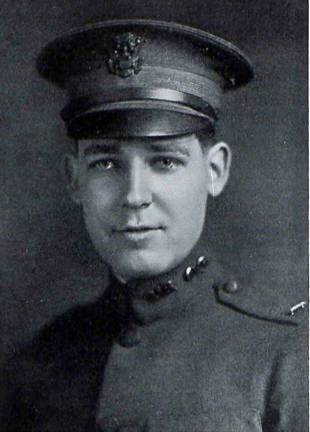Warwick's Citizens in the Great War: Scholar Charles Frances Hawkins

By Aaron Lefkowitz
WARWICK — A hundred years ago, the normal amount of education most Americans had was drastically less than what we have today. Many Americans had to drop out of school, some as early as elementary level, to support their families.
Most careers of the era did not require a degree, only the ability to learn a skill or trade. In fact, illiteracy was so high in America in the early part of the century, that some aptitude tests for military recruits has no words, only pictures.
Only the wealthy and very intelligent would go on to college, individuals pursuing challenging fields like medicine, engineering and law. Many of the career officers of the US Military were college educated, a great deal of them at West Point. AEF Commander, John Pershing, himself only attended West Point for the education over military service. One local resident, who far exceeded the educational level norm of the time and even stands tall today is Charles Frances Hawkins.
In 1914, when World War I began, Hawkins was pursuing a Bachelor’s Degree in Science as a Rhodes Scholar at the world-renown University of Oxford’s constituent college, Balliol College in England.
In December of that year, he was one of the only eight selected from all of Oxford’s Rhodes Scholars for work with the Commission for Relief in Belgium.
With Germany’s harsh occupation of Belgium and subsequent requisition of most of the Belgian peoples’ food, mass starvation was imminent unless something was done.
Under the leadership of Herbert Hoover, who was a master of mass-logistics, the commission helped deliver 5.7 million tons of food to nine and half million Belgians, making it a massive success.
Hoover’s expertise was so great, that when America entered the war, President Woodrow Wilson appointed him head of the U.S. Food Administration, responsible for both American and Allied food reserves, another task, that he completed well, leading to him riding his reputation to the White House in 1928.
Hawkins would spend six months performing this noble deed, but toward the end of his stint, a great sin was being committed in the west of Belgium.
As Germany’s hopes of a swift and absolute victory were dashed and the situation became grim with the war slipping into stalemate, a new weapon was necessary to give the German’s an advantage.
Fritz Haber, head of the Chemistry Section in the Ministry of War, had used his brilliance to develop such a weapon. On April 22, 1915, Haber personally oversaw the devastating effects of the usage of his poison gas on the opening day of the Second Battle of Ypres, an event, which would horrify the world, defiance of the 1899 Hague Convention, during which the major world powers including Germany had agreed to not use poison gas.
The unprepared Allies were caught off-guard but were able to hold back the German attacks. This would be the beginning of the chemical warfare as both sides would produce and deploy massive quantities of various horrifying gases daily, over the next three and a half years of the war, on multiple battle fronts.
When the United States officially enter in April 1917, the military leaders knew that a proper organization was necessary for the development, usage, and countering of chemical weapons.
This organization would be the Chemical Warfare Service, which would be given a great deal of funds and manpower.
At the same time, Hawkins had graduated with his degree and was a chemistry instructor at Williams College. He would resign to enlist on Feb. 27, 1918, and would be assigned to CWS research experiment lab at American University in Washington, D.C.
After the war, the CWS would become the Chemical Corps and has changed its objective to exclusively, protection against chemical weapons.
Twice Hawkins would be severely burned, during experiments, causing him to be hospitalized in July, returning to active duty on Oct. 15.
Hawkins would receive his commission as second lieutenant, making him an officer on Nov. 7, four days before the Armistice.
At the same time, the Spanish Influenza Epidemic was running rampant across the world, sickening and killing countless millions.
On Dec. 27, 1918, six days after he was discharged, Hawkins would succumb to the influenza exacerbated by his weakened health from gas exposure.
Not all who served, were in combat units, some had skills best used in a laboratory. Nonetheless, brilliant citizens like Hawkins served their nation, just as willingly and proudly. The scientists in their line of duty, were also risking their lives for the war effort.
Service was what was expected of all able-bodied men of the time, no matter where that took you.
Hawkins is an interesting fellow as one can debate, if he is a citizen of Warwick. Technically, Hawkins lived in Warwick and is on their Honor Roll plaque, not on any other.
However, he is listed on some Chester Historical Society documents as belonging to Chester, with the strongest argument for this being, that he is buried in the Chester Cemetery in a family obelisk.Which would make him a “permeant” resident of the Chester, resulting in both towns can claim him with good reason.